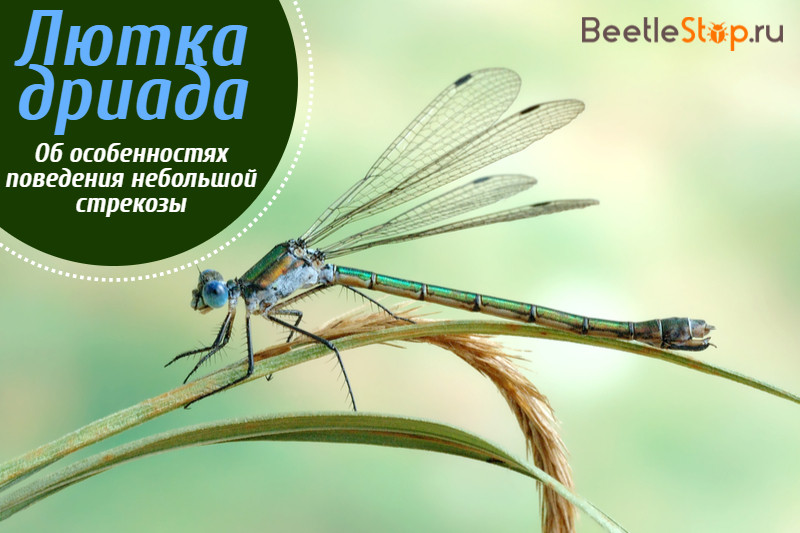Lyutka dryad - a slender dragonfly near small lakes
Small, thin dragonfly family dragonflies are cosmopolitan. The inhabitants of all continents are familiar with these insects. There are only 9 genera and 153 species. Common color options are bronze and green, the colors have a metallic sheen. Lyutka dryad is a representative of the genus Lestes, whose name is translated from Greek as a predator. A small dragonfly is active throughout the summer, lives everywhere except in the Far North.
Morphological description of the species
Dryut cradle (Lestes dryas) belongs to the suborder of Damselfly, the cradle family, the genus Lestes. Body length 35-42 mm, wingspan 47-50 mm. The head is black, facet eyes of a spherical shape are located on the sides, do not touch each other. The complex organ of vision consists of tens of thousands of small eyes. The head and chest are covered with short blond hairs.

Males and females are colored the same; bronze-green with a metallic tint predominates on their bodies. But by some signs, dryads can still be distinguished. The male has blue eyes, the lower part of the chest and abdomen is covered with blue plaque with age. The eyes of females are usually green or brownish. The chest on the sides and bottom is yellow. The male abdomen ends with black tick-shaped genitalia.
The front and rear wings are the same shape and size. Transparent. Pterostigma is located far from the top of the wing. Dragonflies rest with spread wings, shifting them a little back. The limbs are black, completely covered with setae.
Distribution area
Dryut cradle is one of the typical Holarctic species. It is distributed throughout northern Eurasia. Habitats occupy the whole of Europe; populations are declining in the Mediterranean. Dragonflies are found in the Caucasus, Central Asia, Turkey, Afghanistan, and Kazakhstan. The east spread to Korea, Japan and China. Lyutki live in Canada and North America. Dryads live in mountainous areas at an altitude of up to 2500 m.
Features of behavior and habitat
Dryads in the south of the habitat appear in April, in the more northern latitudes - May. Fly until September. Damselflies are slow in flight, so they are not removed from water bodies. They prefer shallow, stagnant, well-warmed lakes and ponds. Such places provide a high temperature for the development of larvae, but in the absence of rain they are prone to drying out.
Insects select areas with dense coastal vegetation. They spend a lot of time sitting on reeds and sedges, rarely fly over open water. Winged predators feed on mosquitoes and midges, helping to reduce the number of harmful insects. The prey is caught and eaten in flight. Males divide the territory among themselves and zealously protect the borders of the site. Only females are allowed to mate.
Interesting fact. Lyutki do not like to move away from the water's edge, but gusts of wind often carry away dragonflies resting with spread wings.
Offspring development
Mating of flocks occurs on plants. The male grabs the female’s head with hooks at the end of the abdomen. The female bends the abdomen and presses it against the partner's copulative organ. While laying eggs, a couple of dryads stick together.The female uses the ovipositor to place the eggs in the tissues of aquatic plants. It is typical for it to place the masonry in one straight line, sometimes reaching 40 cm. The total fecundity of the flute is 50-70 eggs. The masonry is left in the surface part of the vegetation, which falls into the water in autumn.
Information. Dragonflies are characterized by incomplete transformation, their nymphs immediately turn into adults, bypassing the pupal stage.
Eggs laid in early autumn remain wintering in a diapause state. In spring, larvae appear. At first, the offspring kept near the vegetation. Nymphs develop rapidly, it takes 8-10 weeks to become an adult. In the lute larvae, the body is smooth, elongated, painted brown. The head is wide and short, with a spoon-shaped mask. With its help, the larva grabs prey. At the end of the abdomen there are flat tracheal gills. Larvae easily sacrifice one of the three plates, fleeing predators. Gills are regenerated. Dryad nymphs grow to 22-25 mm. Transformation into a dragonfly occurs in the air.
Security status
The numerous and widespread species in some regions is vulnerable. Individual populations are isolated or in unfavorable conditions associated with water pollution. Especially the decrease in numbers affected insects living in the south of the range. Species lyutka dryad fell into the IUCN Red Book, regional books of the Kostroma region and the Kabardino-Balkarian Republic.

